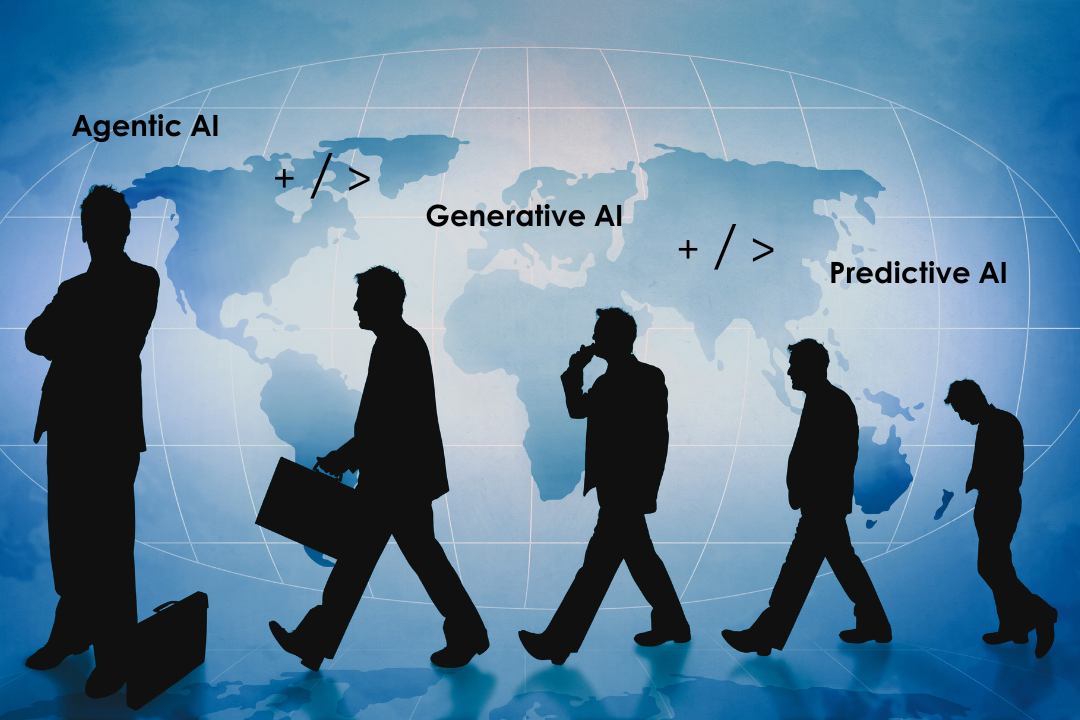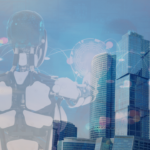Is Agentic AI Replacing Generative AI & Predictive AI in Enterprise Setup?
The rapid evolution of artificial intelligence (AI) has introduced new capabilities into enterprise setups. While Generative AI (GenAI) has transformed content creation and Predictive AI has provided data-driven foresight, the emergence of Agentic AI raises an important question: Is Agentic AI replacing these AI types, or is it complementing them?
To answer this, let’s explore how Agentic AI compares with Generative and Predictive AI and why enterprises are increasingly adopting it.
Understanding the Roles of GenAI, Predictive AI, and Agentic AI
Before exploring the specific roles of Generative AI (GenAI), Predictive AI, and Agentic AI, it’s crucial to understand Foundation Models, the backbone of advanced AI systems. It forms the core architecture on which advanced AI systems, including GenAI and Agentic AI, are built. These models are pre-trained on extensive datasets covering diverse types of information, enabling them to be fine-tuned for specific tasks or domains with relative ease.
Foundation Models vs. GenAI: While both Foundation Models and Generative AI (GenAI) are integral to modern AI systems, they serve distinct purposes. Foundation Models are the broad, adaptable models that provide the core cognitive framework for a variety of AI applications. These models are pre-trained to recognise patterns across vast datasets and can be fine-tuned for tasks ranging from image recognition and speech processing to complex decision-making. Essentially, Foundation Models enable AI to understand, predict, and interact with data at a deep, contextual level, empowering applications in fields like healthcare, finance, and autonomous driving.
On the other hand, GenAI is a specific, highly specialised subset of Foundation Models. GenAI focuses on creating new content, such as text, images, and even code, based on learned patterns. For example, tools like ChatGPT are designed to generate coherent text responses, while DALL·E is known for creating images from text descriptions. GenAI is tailored to produce outputs that mimic human creativity, but it remains limited to content creation and lacks the ability to autonomously reason, make decisions, or interact with its environment. GenAI essentially leverages the foundational capabilities of Foundation Models to focus on one key function: the generation of new content.
Predictive AI excels in analysing historical data to forecast trends and outcomes. It’s widely used in financial modeling, customer behavior analysis, and risk assessment. For instance, it can predict which customers are likely to churn or what stock trends to expect. However, Predictive AI requires humans to interpret and act on its forecasts.
As discussed in our previous blog “What Makes Agentic AI ‘Agentic’?”, Agentic AI operates autonomously, making decisions, planning actions, and executing tasks independently. It combines reasoning, adaptability, and execution, bridging the gap between data insights and actionable results.
In enterprise settings, Agentic AI functions like a central brain that reasons how to achieve a desired goal at scale by leveraging available inputs and tools. It determines what tasks are needed and autonomously orchestrates the right tools from its “toolbox.” These tools could include models for data extraction, APIs for inserting records, or event-driven services that receive data from other processes. By seamlessly calling these components, Agentic AI enables extreme automation, minimising human intervention while ensuring operational efficiency and scalability. It continuously plans, executes, and interacts with data, self-assesses progress, and adjusts its actions until the objective is achieved, then loops back to orchestrate the next steps if necessary.
An example in the banking industry, KYC (Know Your Customer) processes typically involve complex tasks such as document consolidation, information validation, web searches for more comprehensive reports, and name screening against multiple databases with countless combinations. These steps often result in long processing times and high human involvement due to manual cross-checking and data reconciliation.
With a Single AI Agent Framework, the process becomes streamlined. The Agentic AI acts as the central brain and memory, seamlessly orchestrating tasks by autonomously calling tools like OCR systems for document extraction, APIs for data validation, and compliance engines for name screening. This creates a continuous loop workflow that automates repetitive tasks while enabling real-time adjustments and corrections. As a result, the KYC process reduce over 50% of the time, with the same or even better output compared to traditional manual workflows.
Here’s a comparison table to breakdown the differences between GenAI, Predictive AI, and Agentic AI:
| Type | Primary Function | Strengths | Limitations | Examples |
| GenAI | Creates new content based on learned patterns from data. | Excels at generating text, images, music, and code; highly creative and versatile. | Limited understanding of context; prone to inaccuracies, biases, and potential misuse like deepfakes. | ChatGPT, DALL·E, Stable Diffusion, Enterprise GenAI |
| Predictive AI | Analyses historical data to forecast future trends and outcomes. | Delivers highly accurate predictions for decision-making; widely used in finance, healthcare, and logistics. | Requires human intervention to act on predictions; cannot execute tasks or adapt to changing conditions. | Predictive analytics in CRMs, fraud detection. |
| Agentic AI | Operates autonomously, orchestrates required tasks by reasoning and planning, self-assessment and correction, self-optimisation for continuous objective achieved | Operates autonomously, orchestrates required tasks by reasoning and planning, self-assessment and correction, self-optimisation for continuous objective achieved | Requires integration with multiple tools, initial setup complexity still developing in terms of mass-market deployment. | Enterprise automation, dynamic workflows, autonomous systems. |
Is Agentic AI Replacing Generative and Predictive AI?
Agentic AI isn’t replacing Generative or Predictive AI—it’s enhancing their capabilities and filling critical gaps. Here’s how these AI types coexist and complement each other:
- Agentic AI use Generative AI as a Foundation:
Generative AI excels at creating new content, such as personalised messages, synthetic data, or even product designs. However, it requires an external system or human involvement to decide when and how to use its outputs. Agentic AI fills this gap by orchestrating tasks that require generated content.
Example: In customer service, Generative AI can draft personalised email responses, while Agentic AI autonomously determines when to send these responses, integrates them with CRM systems, and schedules follow-ups—minimising human involvement while ensuring a personalised experience.
- Agentic AI uses Predictive AI as a Tool:
Predictive AI provides valuable forecasts, but the next step—taking action—has traditionally been a human task. Agentic AI takes these predictions and autonomously transforms them into actionable decisions, eliminating delays and human error.
Example: In banking, Predictive AI might flag high suspicious transactions based on risk patterns. Agentic AI takes the next steps by freezing the account, notifying the compliance team, and alerting the customer—all in real time, without waiting for manual approvals.
Why Enterprises Are Turning to Agentic AI
The growing adoption of Agentic AI in enterprise setups is driven by its unique ability to integrate and act on the strengths of other AI types. Here’s why:
- From Insight to Action:
Unlike Generative and Predictive AI, which provide outputs that require further action, Agentic AI completes the loop by autonomously acting on insights. This reduces decision-making bottlenecks and speeds up operations. - Enhanced Scalability:
Agentic AI enables enterprises to scale operations more effectively. By automating complex workflows, it minimises the need for human intervention and ensures consistent performance. - Autonomy in Complex Environments:
Agentic AI thrives in dynamic and complex environments. Whether it’s handling customer interactions or managing compliance tasks, it adapts and evolves to meet organisational goals without constant supervision. - Seamless Integration Across AI Types:
Instead of replacing existing AI systems, Agentic AI integrates seamlessly, enhancing their utility. Enterprises can continue to benefit from Generative and Predictive AI while adding a layer of autonomous action.
Real-World Applications of Combined AI Across Industries
- Banking:
In the fast-paced world of banking, combining AI capabilities ensures a seamless and secure customer experience. Predictive AI forecasts fraudulent activities by analysing transaction patterns, while GenAI drafts personalised messages to alert customers. Agentic AI takes this further by autonomously freezing suspicious accounts, notifying compliance teams, and initiating follow-ups with affected clients. This integrated approach not only prevents fraud but also streamlines operations, enabling banks to maintain trust and efficiency in a highly regulated industry. Mckinsey stated an illustrative use case about agent-based GenAI system for loan underwriting, it could eliminate review cycle times by 20-60% of credit-risks memo process as shown below:
Source from: Why agents are the next frontier of generative AI
- Insurance:
The insurance sector thrives on efficiency and accuracy, especially during claims processing. Predictive AI can analyse historical claims data to identify high-risk cases, while GenAI generates personalised explanations for policyholders. Meanwhile, Agentic AI ensures the process runs smoothly by autonomously verifying claims, cross-checking regulatory compliance, and expediting payouts for legitimate claims. For example, in a natural disaster scenario, Agentic AI can prioritise urgent claims, ensuring rapid assistance for those most in need. A Dutch insurance company implemented Agentic AI to automate up to 90% of its claims processing tasks, reducing manual intervention and operational costs.
- Healthcare:
In healthcare, the combination of these AI types can significantly improve patient outcomes. Predictive AI identifies high-risk patients by analysing medical history and real-time data. GenAI crafts detailed, personalised care instructions, while Agentic AI ensures that these plans are executed by scheduling follow-ups, sending medication reminders, and alerting doctors if a patient’s condition worsens. This seamless integration supports proactive care, reduces readmission rates, and enhances the overall patient experience, which boost overall healthcare productivity by deducting 30% of diagnostic times and 40% of administrative processing times.
- Government:
Governments handle vast amounts of data that require timely processing for decision-making. Predictive AI can forecast public service demand, such as housing applications or healthcare resources, based on demographic trends. GenAI drafts policies or public-facing content to address citizen inquiries, and Agentic AI autonomously processes applications, verifies eligibility, and allocates resources efficiently. For instance, during a crisis like a pandemic, Agentic AI can dynamically adjust resource distribution based on real-time data, ensuring equitable access to critical services. In procurement department of public sector, Cambridge Management Consulting reported that agentic AI improves the entire procurement cycle that reduce risks and reduce elapsed time to next-step outcomes.
- Education:
The education sector benefits greatly from AI-driven personalisation and scalability. Predictive AI identifies students at risk of underperforming by analysing attendance, participation, and grades. GenAI creates tailored study plans and feedback, while Agentic AI ensures execution by scheduling tutoring sessions, sending assignment reminders, and even connecting students with additional learning resources. This combination not only supports students in achieving academic success but also reduces the administrative burden on educators.
The Future of AI in Enterprise
Agentic AI doesn’t aim to replace Generative or Predictive AI, it complements them by turning insights and outputs into action. Together, these AI types form a powerful ecosystem that empowers enterprises to operate more efficiently, adapt faster, and achieve better outcomes.
As enterprises continue to explore the possibilities of AI, the combination of Generative, Predictive, and Agentic AI will redefine the future of automation and decision-making.
For more on Agentic AI and its capabilities, check out our blog “What Makes Agentic AI ‘Agentic’?”.












